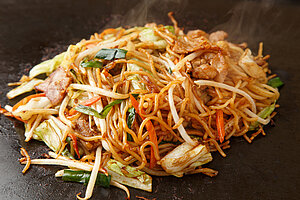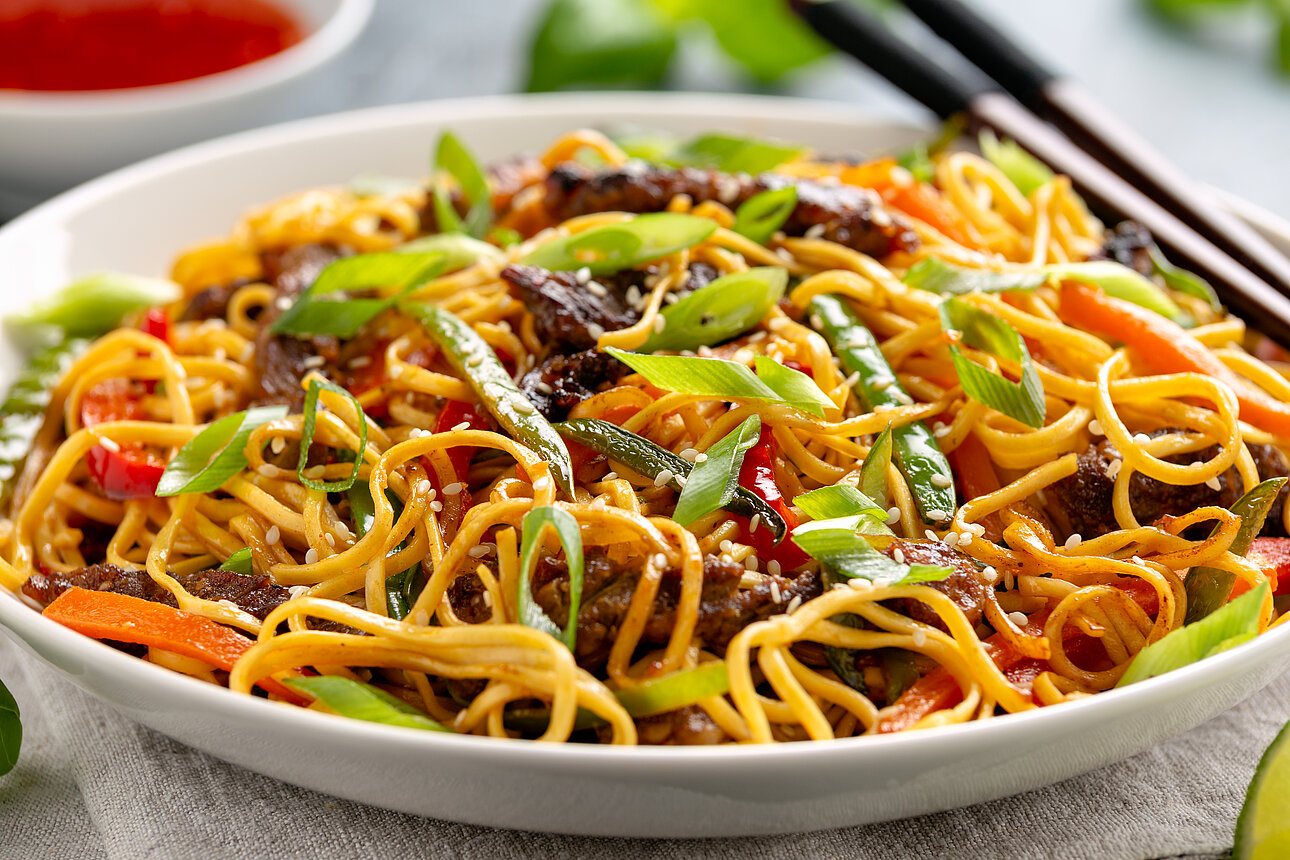Stir-fry is a staple of many Asian cuisines, beloved across generations as a hearty, satisfying meal. While many dishes spread stir-fried proteins and vegetables over rice, others mix them with noodles. The rich diversity of noodle dishes has even led to regional specialties. Today, the ways that consumers enjoy stir-fried noodles is changing. Here are the latest trends and flavors for stir-fry noodles and how consumers are shaping the market.
 Modern Consumer Preferences
Modern Consumer Preferences
Consumers often lean toward the tastes and sensations of their childhood and youth, although preferences can continue to evolve over time.
In previous generations, consumers tended to focus more on functional foods, high-quality ingredients, and classic stir-fry noodles. Today, these factors remain important, but they’re only part of what consumers want. Modern consumers are seeking smaller, more frequent meals, functional snacks, clean ingredients, humanely raised meats, plant-based proteins, and vegan and vegetarian foods. Gen Z and Millennials are the generations driving these trends, followed by older generations like Gen X and Baby Boomers.
Today’s consumers also have a strong concern for the environment and sustainable sourcing. They want to know that what they’re eating is sustainably sourced and socially and culturally conscious. They also want to try new things. While comfort foods are appreciated, Gen Z is more daring with flavors. These consumers love the latest trends and go out of their way to create share-worthy experiences.
Overall, Asian stir-fry food preferences should cater more toward holistic values, exceptional ingredients, sensory experiences, and bold, adventurous combinations. Modern consumers have strong ideas of what they like, but they're eager to explore more of the world's offerings.
Current Stir-Fry Noodle Trends
Popular stir-fry dishes over the past five years show that consumers are excited about rich umami flavors and heat-filled ingredients. We see that spicy noodles have often taken the number one spot, showing the influence of invigorating, fiery ingredients.
Other current stir-fry trends appeal to other taste buds. Miso, with its salty, rich mouthfeel and subtle tang, adds a savory taste and texture both welcoming and filling. Soy sauce is another leading noodle trend, offering bold saltiness and moderate umami notes. This flavor profile even brings a touch of sweet and bitter, creating broad taste bud appeal.
Shoyu, another type of soy sauce, has a sweeter profile and richer umami taste. It tends to focus on minimal ingredients, which fits with the current trend of simple origins and conscious eating. Some of the highest-quality shoyu uses only four ingredients: soybeans, wheat, salt, and water. This simple combination allows the deep flavors harmonize and accentuate one another without interference.
Stir-fry also doesn’t shy away from meat proteins. Pork and chicken have shown solid popularity across the last five years, and these meats have maintained their presence despite an increased interest in plant-based proteins. While beef flavors have been more variable, the subtle sweetness of pork and savory umami of chicken have kept pace with changing consumer preferences. Tonkotsu, or pork broth, is highly popular, offering a rich flavor, creamy color, and silky mouthfeel to elevate stir-fry noodles and act as an intriguing counterpart to traditional ramen.
We also see that savory, hot, and ginger flavor profiles have maintained a presence in the top trends for stir-fried noodles. Savory flavors bring plenty of umami and earthy notes, along with a meaty profile and noticeable richness.
In terms of hot flavors, these often trend toward spicy heat and fiery chilis. However, they can also include pungent ground spices, peppercorns, bold aromatics, and varying degrees of intensity. Ginger often goes along with hot flavors due to its warmth and pungent aroma. However, it can also work to add subtle sweetness depending on its preparation.
Related: Ramen Trends To Look for in 2024
 Innovative Flavor Profiles
Innovative Flavor Profiles
Rather than mainstream favorites, innovative flavors are where stir-fry noodles are seeing the most change. These types have shifted away from the classics to welcome flavors and ingredients with a more global perspective.
Novel Flavors
There’s something to be said for reaching around the world to see what people enjoy. This is where we see the most innovative combinations, with intriguing blends of regional cheeses, bacon, honey, and red chilis. Cheese-topped stir-fry keep things mild but fresh, especially colby cheese with its mild saltiness or monterey jack cheese with its subtle tang. Stir-fry flavors with these cheeses take on a creamy and delicious texture that adds to the sensory experience.
Bacon is another intriguing flavor profile. This ingredient has a savory quality, crisp texture, and unmistakable aroma, bringing a unique taste to noodle dishes. Whether used as crumbled bacon or small strips, bacon serves as a bold way to accentuate the savory sauces and stir-fried vegetables.
Garam masala and wasabi are also gaining attention for the way they elevate noodles. From the warmth of cinnamon, cardamom, and cumin to the pungent aroma and intense heat of wasabi, alternative flavor profiles are both exciting and bold. This is a key reason why modern consumers, especially Gen Z, are remaining so enticed.
At the opposite end of the spectrum, honey adds unique sweetness. The varieties lend everything from fruity notes from blackberry flowers, to bold intensity from buckwheat or neem blooms. Other honeys might see complex wildflowers or rich sage with hints of pine or juniper.
Stay Informed, Stay Inspired - Subscribe to our Newsletter Here!
Chef-Driven Flavors
As stir-fry continues to see popularity among professional chefs in addition to home cooks, we see flavor profiles with a higher degree of innovation. These chef-driven flavors take ingredients from global cuisines and spin them into exciting new combinations.
In Chilean stir-fry, for example, there’s a preference for simple ingredients with exceptional presentation. A common blend might use spicy aji peppers with tomatoes, garlic, coriander, and olive oil. Another might mix paprika pepper with herby vegetable medleys of corn, pumpkin, red potatoes, oregano, and garlic. Other Latin American flavors experiment with these rich combinations, introducing with ceviche-inspired stir-fry dishes featuring seafood, limes, cilantro, onions, quinoa, beans, and avocado.
Many noodle stir-fry dishes also pay homage to other cuisines, in particular French, Italian, and Hawaiian. We see intriguing beef stir-fry concepts with hints of tomato, red wine, and carrots, and chicken stir-fry highlighting white wine, cream, and pearl onions. Other chef-inspired ideas focus on Hawaiian concepts with tropical fruits, taro, and savory meats. These aromatic flavor seasonings offer the best of many diverse cuisines in a stir-fried noodle base.
 Rising Trends in Stir-Fry
Rising Trends in Stir-Fry
Looking at the latest trends in stir-fry flavors, there’s a growing interest in nutty sweetness along with fiery heat. While some dishes use macadamia as the focal ingredient, others might add peppercorns to drive up the heat and touch on several taste bud senses.
Other fast-growing flavor profiles bring the honeyed bitterness of almond and the tangy sweetness of barbecue. With complex flavor notes, they tap into the deeper nuances of Asian stir-fry and leave consumers wanting more. Tropical fruits are also on the rise with popular stir-fry flavors, from sweet and nutty coconut to tangy mango with its mild floral and evergreen notes. Tamarind, with its sweet-sour profile hinting at apricot and caramel, has also started to appear in some of the best stir-fry flavors as well.
Peanuts are equally popular with consumers, especially when mixed with proteins like chicken or tuna. Chicken, peanuts, celery, ginger, and red chili paste create bold aromatics, while tuna, shiitake mushrooms, okra, peanut oil, and tofu unveil savory complexity.






